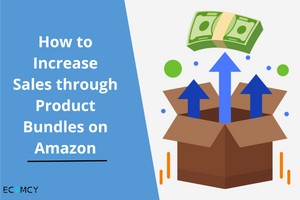How to Increase Sales through Product Bundles on Amazon
December 04, 2023

In the dynamic world of e-commerce, standing out amidst the sea of products on Amazon can be a challenging feat. As a seller, the key lies not just in offering great products but also in strategic marketing. One effective strategy that has proven to boost sales is product bundling. This article will delve into the intricacies of bundling for success on Amazon, answering key questions and providing valuable insights to enhance your sales game.
Why Consider Product Bundling?
Increased Perceived Value:
-
Bundle Configurations - Carefully curate bundles that genuinely enhance the customer's experience, combining products that make sense together. For instance, if selling a camera, consider bundling it with a tripod, memory card, camera bag, and lens cleaning kit for a complete package.
-
Strategic Pricing - While offering a discount, ensure that the bundled price reflects genuine savings. The perceived value should be evident to customers, encouraging them to choose the bundle over individual items.
-
Exclusive Bundles - Create exclusive bundles with items that aren't available for individual purchase, giving customers a unique and enticing offer.
-
Bundled Services - Consider bundling products with related services, such as offering a free e-book with a tablet or a one-month subscription with a fitness equipment purchase.
Improved Sales Velocity:
-
Algorithmic Benefits - Understand how Amazon's algorithm rewards products with higher sales velocity. By increasing the number of items sold per transaction through bundling, your product gains visibility, leading to more organic sales.
-
Strategic Placement - Consider placing your bundled products strategically in search results, taking advantage of their higher perceived value to attract clicks and conversions.
-
Frequent Updates - Regularly update your bundles to align with customer preferences and market trends, ensuring consistent sales momentum.
-
Free Shipping Incentives - Offer free shipping on bundled products to further entice customers, as it adds an extra layer of perceived value.
Enhanced Cross-Selling Opportunities:
-
Complementary Pairing - Pair products that complement each other, encouraging customers to explore related items. For example, if selling a fitness tracker, consider bundling it with a water bottle, workout towel, and a set of resistance bands.
-
Bundle Marketing - Leverage your marketing efforts to highlight the convenience and cost-effectiveness of purchasing the bundle, showcasing the added value customers receive.
-
Themed Bundles - Create themed bundles that resonate with specific customer interests or occasions, such as a "Home Office Productivity Bundle" featuring a desk organizer, noise-canceling headphones, and a desk lamp.
-
Subscription Bundles - Introduce subscription-based bundles, offering customers a discount for subscribing to receive a set of products regularly.
How to Identify Products for Bundling?
Complementary Items:
- Customer Behavior Analysis - Examine customer purchase patterns to identify frequently co-purchased items. This data can guide you in bundling products that naturally go together.
- Customer Surveys - Engage with your customer base through surveys to directly understand their preferences and uncover potential pairings they find appealing.
- Seasonal Adjustments - Modify your bundled offerings based on seasonal changes and customer needs, ensuring relevance throughout the year.
Seasonal or Trend-Driven Bundles:
- Market Trend Analysis - Stay abreast of market trends and seasonal demands. Create bundles that align with these trends to capture the attention of customers actively seeking thematic products.
- Limited-Edition Bundles - Introduce limited-edition bundles tied to specific seasons or events, creating a sense of exclusivity and urgency.
- Holiday Bundles - Craft special bundles for holidays, providing customers with convenient gifting options and capitalizing on festive spending.
- Back-to-School Bundles - Develop bundles tailored for back-to-school seasons, including relevant items like backpacks, stationery, and electronics.
Addressing Customer Needs:
- Review Analysis - Dive into customer reviews to identify common needs or desires. Bundling products that fulfill these requirements increases sales and enhances customer satisfaction.
- Customizable Bundles - Consider offering customizable bundles, allowing customers to choose specific products within a set category to tailor the bundle to their preferences.
- Problem-Solving Bundles - Identify common pain points customers face with your products and create bundles that address these issues. For example, bundling a smartphone with a durable case and screen protector.
- Educational Bundles - Develop bundles with educational content, such as online courses or instructional guides, enhancing the overall value proposition.
Implementing Effective Product Bundling Strategies
Pricing Considerations:
-
Discount Clarity: Ensure that the discount offered in the bundle is clearly communicated. Customers should easily recognize the financial advantage of purchasing the bundled package.
-
Tiered Pricing: Experiment with tiered pricing options, such as offering additional discounts for purchasing multiple bundles or including a bonus item for a higher-priced bundle.
-
Bundle-Only Discounts: Occasionally offer special discounts exclusively for customers purchasing bundled products, fostering loyalty among your customer base.
-
Dynamic Pricing Models: Implement dynamic pricing models that adjust based on customer behavior, encouraging higher spending on bundled products.
Bundle Visibility:
-
High-Quality Imagery: Invest in high-quality images that showcase the bundled products. Incorporate various images captured from different perspectives to provide customers with a comprehensive and detailed view.
-
Detailed Descriptions: Craft clear and concise product descriptions, emphasizing the benefits and unique features of each bundled item. Use bullet points for easy readability.
-
Video Demonstrations: Create video content demonstrating the use and benefits of your bundled products, providing customers with a more immersive understanding.
-
Comparison Tables: Include comparison tables in your product listings, highlighting the cost savings and additional features of the bundled option.
Limited-Time Promotions:
-
Flash Sales: Introduce flash sales on your bundled products, creating a sense of urgency. Emphasize the limited availability of the discounted bundle to drive quicker decision-making.
-
Countdown Timers: If selling on your website or through other channels, consider incorporating countdown timers to visually highlight the remaining time of the promotion.
-
Early Access Promotions: Reward loyal customers with early access to bundle promotions, fostering a sense of exclusivity and appreciation.
-
Social Media Teasers: Use your social media channels to tease upcoming bundle promotions, generating anticipation and excitement among your audience.
Overcoming Potential Challenges
Inventory Management:
-
Automated Systems - Implement automated inventory management systems to track stock levels in real-time. Set up alerts for low-stock items to proactively manage inventory.
-
Strategic Bundling - Plan bundles strategically, considering the availability of each item. If one component runs out, it could affect the entire bundle's sales potential.
-
Pre-Order Options - Introduce pre-order options for popular bundles, allowing customers to secure their purchase even if certain components are temporarily out of stock.
-
Collaborative Planning - Collaborate with suppliers to ensure a steady and timely flow of inventory for bundled products.
Customer Education:
-
Clear Communication - Clearly communicate the value of your bundles through marketing materials, product listings, and customer support channels. Address frequently asked questions about the bundled offerings.
-
Tutorial Content - Create tutorial content, such as videos or blog posts, demonstrating the practical benefits of using the bundled products together.
-
Customer Webinars - Host webinars to educate customers on the advantages of your bundled products, allowing for direct interaction and Q&A sessions.
-
Interactive Product Demos - Implement interactive product demos on your website, allowing customers to virtually experience the bundled products.
Analyzing Performance:
-
Data-Driven Decision-Making - Regularly analyze sales data and customer feedback to identify trends and make data-driven adjustments to your bundling strategy.
-
A/B Testing - Conduct A/B testing on different bundle configurations to understand which combinations resonate better with your target audience.
-
Customer Surveys - Leverage customer surveys to gather insights on the satisfaction levels of customers who have purchased bundles, identifying areas for improvement.
-
Competitor Analysis - Monitor the bundling strategies of competitors, identifying gaps in the market and potential areas for innovation.
Leveraging Amazon's Promotional Tools
Lightning Deals:
-
Strategic Timing: Plan Lightning Deals during peak shopping times, holidays, or special events to maximize visibility and customer engagement.
-
Bundle Highlighting: Clearly indicate the bundled products in your Lightning Deal promotions, making it evident that customers are getting a special discount on a package.
-
Cross-Promotion: Collaborate with other sellers to cross-promote bundled products, expanding your reach and attracting a broader audience.
-
Customer Feedback Integration: Use customer feedback received during Lightning Deals to refine and enhance your bundled offerings.
Sponsored Products:
-
Keyword Optimization: Optimize your sponsored product listings with relevant keywords to ensure your bundled offerings appear in search results.
-
Bid Adjustments: Experiment with bid adjustments for your bundled products to increase visibility without overspending on advertising costs.
-
Seasonal Campaigns: Align sponsored product campaigns with seasonal trends, adjusting keywords and ad content accordingly.
-
A/B Testing Ad Creatives: A/B tests different ad creatives to understand which visuals and messaging resonate best with your target audience.
Coupons and Discounts:
-
Strategic Couponing: Use Amazon's coupon feature strategically, offering discounts on bundled products to attract budget-conscious shoppers.
-
Promotion Stacking: Consider stacking promotions, such as combining a coupon with a Lightning Deal, for a limited time to create maximum impact.
-
Referral Programs: Introduce referral programs where customers receive additional discounts on bundled products for referring friends, expanding your customer base.
-
Personalized Coupons: Experiment with personalized coupons based on customer purchase history, tailoring promotions to individual preferences.
Conclusion
As the e-commerce landscape continues to evolve, mastering the art of product bundling on Amazon can be a game-changer for your sales strategy. By understanding customer preferences, effectively bundling products, and leveraging Amazon's promotional tools, you can carve out a successful niche in this competitive marketplace. Now, let's delve into the details of each aspect to guide you on the path to increased sales through strategic product bundling.
Leave a comment
Comments will be approved before showing up.




